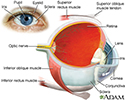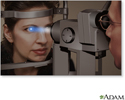Slit-lamp exam
BiomicroscopyThe slit-lamp examination looks at structures that are at the front of the eye.
How the Test is Performed
The slit-lamp is a low-power microscope combined with a high-intensity light source that can be focused as a thin, slit-like beam.
You will sit in a chair with the instrument placed in front of you. You will be asked to rest your chin and forehead on a support to keep your head steady.
The health care provider will examine your eyes, especially the eyelids, cornea, conjunctiva, sclera, and iris. Often a yellow dye (fluorescein) is used to help examine the cornea and tear layer. The dye is added either by touching a small strip of paper to your eye or by adding it as an eyedrop. The dye rinses out of the eye with tears as you blink.
Next, drops may be placed in your eyes to widen (dilate) your pupils. The drops take about 15 to 20 minutes to work. The slit-lamp examination is then repeated using another small lens held close to the eye, so the back of the eye can be examined.
How to Prepare for the Test
No special preparation is needed for this test.
How the Test will Feel
Your eyes will be sensitive to light for a few hours after the exam if dilating drops are used.
Why the Test is Performed
This test is used to examine the:
-
Conjunctiva (the thin membrane that covers the inner surface of the eyelid and the white part of the eyeball)
Conjunctiva
The conjunctiva is a thin, clear membrane that covers the inner surface of the eyelid and the white part of the eyeball (the sclera). It contains ma...
 ImageRead Article Now Book Mark Article
ImageRead Article Now Book Mark Article - Cornea (the clear outer lens on the front of the eye)
- Eyelids
-
Iris (colored part of the eye between the cornea and lens)
Iris
The iris is the colored part of the eye. It is located between the cornea and lens. The round, central opening of the iris is called the pupil. Ve...
 ImageRead Article Now Book Mark Article
ImageRead Article Now Book Mark Article - Lens
-
Sclera (the white outer coating of the eye)
Sclera
The sclera is the white outer coating of the eye. It is tough, fibrous tissue that extends from the cornea (the clear front section of the eye) to t...
 ImageRead Article Now Book Mark Article
ImageRead Article Now Book Mark Article
Normal Results
Structures in the eye are found to be normal.
What Abnormal Results Mean
The slit lamp exam may detect many diseases of the eye, including:
- Clouding of the lens of the eye (cataract)
-
Injury to the cornea
Injury to the cornea
Corneal injury is a wound to the part of the eye known as the cornea. The cornea is the crystal clear (transparent) tissue that covers the front of ...
 ImageRead Article Now Book Mark Article
ImageRead Article Now Book Mark Article -
Dry eye syndrome
Dry eye syndrome
You need tears to moisten your eyes and to wash away particles that have gotten into your eyes. A healthy tear film on the eye is necessary for good...
 ImageRead Article Now Book Mark Article
ImageRead Article Now Book Mark Article -
Macular degeneration
Macular degeneration
Macular degeneration is an eye disorder that slowly destroys sharp, central vision. This makes it difficult to see fine details and read. The diseas...
 ImageRead Article Now Book Mark Article
ImageRead Article Now Book Mark Article - Separation of the retina from its supporting layers (retinal detachment)
Retinal detachment
Retinal detachment is a separation of the light-sensitive membrane (retina) in the back of the eye from its supporting layers.
 ImageRead Article Now Book Mark Article
ImageRead Article Now Book Mark Article - Blockage in a small artery or vein that carries blood to or from the retina (retinal vessel occlusion)
Retinal vessel occlusion
Retinal artery occlusion is a blockage in one of the small arteries that carry blood to the retina. The retina is a layer of tissue in the back of t...
 ImageRead Article Now Book Mark Article
ImageRead Article Now Book Mark Article - Inherited degeneration of the retina (retinitis pigmentosa)
Retinitis pigmentosa
Retinitis pigmentosa is an eye disease in which there is damage to the retina. The retina is the layer of tissue at the back of the inner eye. This...
 ImageRead Article Now Book Mark Article
ImageRead Article Now Book Mark Article - Swelling and irritation of the uvea (uveitis), the middle layer of the eye
Uveitis
Uveitis is swelling and inflammation of the uvea. The uvea is the middle layer of the wall of the eye. The uvea supplies blood for the iris at the ...
 ImageRead Article Now Book Mark Article
ImageRead Article Now Book Mark Article
This list does not include all possible diseases of the eye.
Risks
If you receive drops to dilate your eyes for the ophthalmoscopy, your vision will be blurred.
- Wear sunglasses to protect your eyes from sunlight, which can damage your eyes.
- Have someone drive you home.
- The drops usually wear off in several hours.
In rare cases, the dilating eyedrops cause:
- An attack of narrow-angle glaucoma
- Dizziness
- Dryness of the mouth
- Flushing
- Nausea and vomiting
References
Atebara NH, Miller D, Thall EH, Brodie SE. Ophthalmic instruments. In: Yanoff M, Duker JS, eds. Ophthalmology. 6th ed. Philadelphia, PA: Elsevier; 2023:chap 2.5.
Chuck RS, Dunn SP, Flaxel CJ; American Academy of Ophthalmology Preferred Practice Pattern Committee, et al. Comprehensive adult medical eye evaluation preferred practice pattern. Ophthalmology. 2021;128(1):1-29. doi.org/10.1016/j.ophtha.2020.10.024. Published November 12, 2020.
Prokopich CL, Hrynchak P, Flanagan JG, Hynes AF, Chisholm C. Ocular health assessment. In: Elliott DB, ed. Clinical Procedures in Primary Eye Care. 5th ed. Philadelphia, PA: Elsevier; 2021:chap 7.
-
Eye - illustration
The eye is the organ of sight, a nearly spherical hollow globe filled with fluids (humors). The outer layer (sclera, or white of the eye, and cornea) is fibrous and protective. The middle layer (choroid, ciliary body and the iris) is vascular. The innermost layer (retina) is sensory nerve tissue that is light sensitive. The fluids in the eye are divided by the lens into the vitreous humor (behind the lens) and the aqueous humor (in front of the lens). The lens itself is flexible and suspended by ligaments which allow it to change shape to focus light on the retina, which is composed of sensory neurons.
Eye
illustration
-
Slit-lamp exam - illustration
A slit-lamp, which is a specialized magnifying microscope, is used to examine the structures of the eye (including the cornea, iris, vitreous, and retina). The slit-lamp is used to examine, treat (with a laser), and photograph (with a camera) the eye.
Slit-lamp exam
illustration
-
Eye lens anatomy - illustration
The lens of the eye is normally clear. If the lens becomes cloudy or is opacified it is called a cataract.
Eye lens anatomy
illustration
-
Eye - illustration
The eye is the organ of sight, a nearly spherical hollow globe filled with fluids (humors). The outer layer (sclera, or white of the eye, and cornea) is fibrous and protective. The middle layer (choroid, ciliary body and the iris) is vascular. The innermost layer (retina) is sensory nerve tissue that is light sensitive. The fluids in the eye are divided by the lens into the vitreous humor (behind the lens) and the aqueous humor (in front of the lens). The lens itself is flexible and suspended by ligaments which allow it to change shape to focus light on the retina, which is composed of sensory neurons.
Eye
illustration
-
Slit-lamp exam - illustration
A slit-lamp, which is a specialized magnifying microscope, is used to examine the structures of the eye (including the cornea, iris, vitreous, and retina). The slit-lamp is used to examine, treat (with a laser), and photograph (with a camera) the eye.
Slit-lamp exam
illustration
-
Eye lens anatomy - illustration
The lens of the eye is normally clear. If the lens becomes cloudy or is opacified it is called a cataract.
Eye lens anatomy
illustration
Review Date: 2/12/2023
Reviewed By: Franklin W. Lusby, MD, Ophthalmologist, Lusby Vision Institute, La Jolla, CA. Also reviewed by David C. Dugdale, MD, Medical Director, Brenda Conaway, Editorial Director, and the A.D.A.M. Editorial team.





